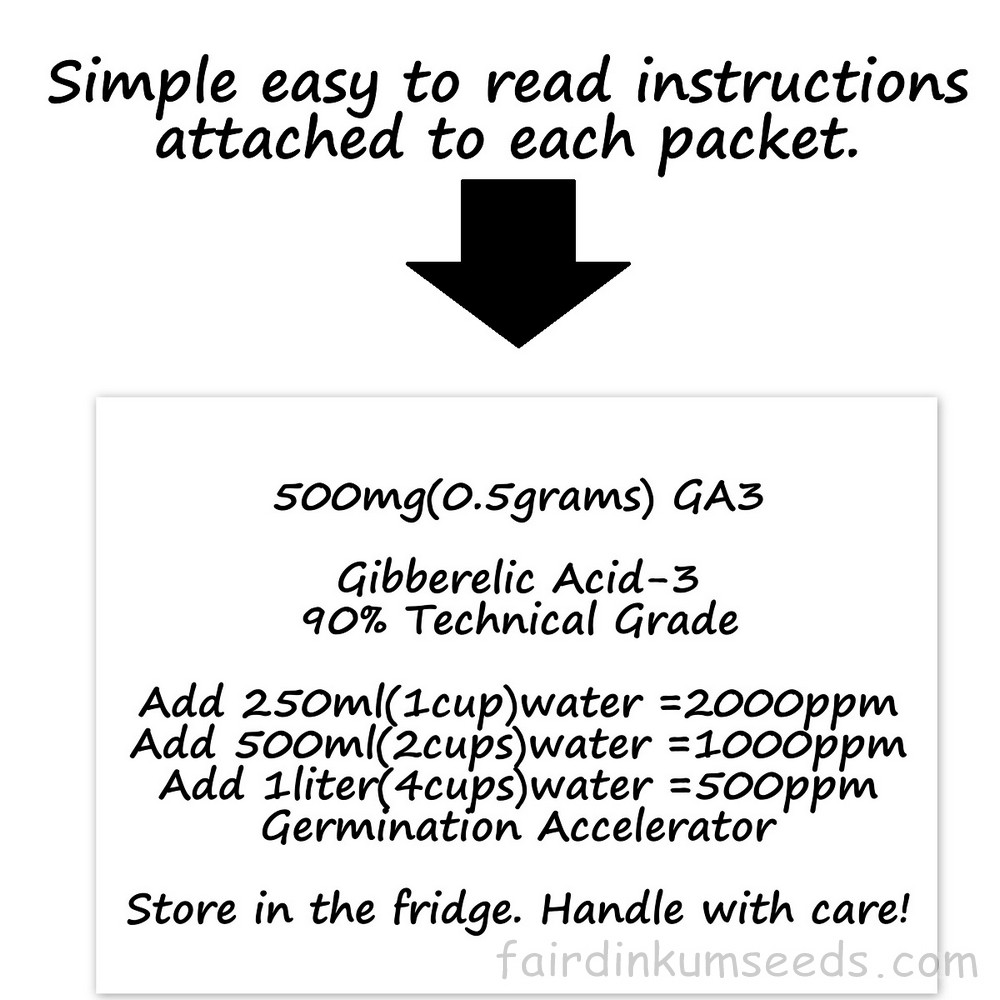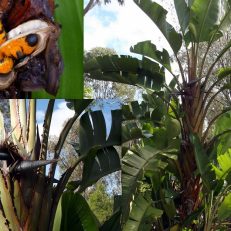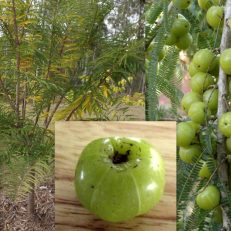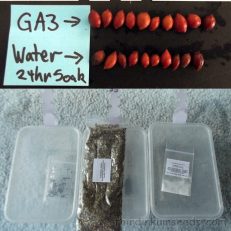Please read text!
GA3 Gibberellic Acid-3 Gibberella Fukikuroi Dormancy Germination Stimulant
Nice big packet of ~500mg or 1/2 a gram of 90% Technical grade, fine mesh, top quality, high purity awesomeness!
Not a big fan on using “chemicals” on anything, just don’t like the idea really?
But I am a big fan of our awesome Aussie native species, I want them all, and I am running a heap of trials with them at the moment.
Due to our harsh climate and sporadic rains, bush fires and huge numbers of herbivores, the plants in OZ are designed to only sprout when conditions are good, and only a couple at a time. Spreads out the risk, but makes “farming” them very difficult.
So, there are three things you can do.
Number 1. Cross fingers.
Just plant as per normal, and wait, and wait and wait and wait, weeks, months years, decades even with some species….
It is my standard method and it works with most, but unfortunately not all species.
Number 2. Scarify.
Damage the shell of the seeds the same way bush fires, insects, flooding etc does in nature. This is a great method, for many things, just use a knife, file or whatever you have lying around. HWT for acacia is a great example. It doesn’t always work though, particularly with some of our rarer Solanum species like bush tomatoes.
Number 3. Smoke.
Simulate a bush fire using my awesome “Smoke treatment for seeds“. Works great for many things, improves germination of both plants and often nearby weeds(making removing them easier)
Number 4. Gibberellic Acid-3, this stuff.
It is a naturally occurring germination stimulant produced by culturing fungi. They basically grow the fungi/mushrooms in water, then sieve it, then dry out the water and extract the GA3 from the solution. The effects are startling.
The fungi that makes it is called Gibberella fujikuroi.
It was discovered in 1898 and a scientist called Shotaro Hori showed that it was the cause of “bakanae” disease or “foolish seedling” in rice.
The large amount of GA3 in the soil(from the naturally occurring local fungi) made the rice to grow long and thin, then fall over and die. Made the seeds burst out of the shell and race to the sun way too fast for their stems to support the weight. Looks very similar to when you put a plant in near total darkness, just much faster.
Big problem for things that germinate easily like rice, and for that reason this stuff is not recommended for easy to grow plants.
Interesting to see, but not sensible if you want healthy plants.
But, for stuff that is designed to sit dormant, things that are hard to germinate, things that need a cold stratification, or scarification, or a huge period of time between planting and sprouting, this stuff is bloody great!
In my tests I see clear consistent improvements in germination of many species.
****Let me be clear, I am not currently selling any plants that have been grown using GA3.****
I am personally only using it in propagation experiments on some of our really rare Australian species, and if/when I ever decide to make those plants available to the public I will advertise the fact I used GA3 for germination.
I make a solution, I soak the seeds in the GA3 solution overnight, I rinse the seeds, and I then plant them as per normal. That once off 24hr soak, is the only time the chemical is applied, and it’s sole purpose is to trick the plant into thinking that now is the ideal time to germinate.
Just makes them shoot.
Trials plants are kept completely separate to all our other plants, in a completely different greenhouse.
All that said, GA3 is in all plants naturally anyway, just at different levels at different times throughout the plants life. Kinda like the way hormone levels in humans change, during pregnancy for example.
GA3 and other closely related Gibberellic chemicals are used commercially on many common food crops you see everyday in the supermarket like bananas, seedless grapes, blueberries, tomatoes, oranges, artichokes, pears, cherries and a whole host of other things, not for germination, but to increase fruit yield. They are sprayed on in small amounts at certain times throughout the season to increase fruit set, slow or speed up growth, improve colour, size, shape etc etc.
Alrighty, now you know what it is, and where it comes from, now onto how to use it.
It is a research tool only.
It is a thing you can try, and it may help, and with some things it may help dramatically like in the picture.
That 24hr soak at 500ppm doubled the seed size and those fellas sprouted within days. The control group, the ones below that did not swell. They were only soaked in rainwater for 24hrs, it is still yet to germinate ~4months later. I am sure they will germinate, but it might be another year or so before they do without the help of GA3. UPDATE, 9months later 1 sprouted. That was all, and now its been so long I gave up completely on them.
Ga3 was definitely the way to go.
GA3 is shown to help considerably with some species of Aldrovanda, Amaranthus, Annona, Aquilegia, Argemone, Artemesia, Atriplex, Azadirachta, Bidens, Billardiera, Brachychiton, Bromeliad, Brugmansia, Byblis, Capsicum, Carica, Carpobrotus, Carrisa, Cephalotus, Cereus, Chenapodium, Cissus, Citrus, Cornus, Corylus, Cupressus, Cyclamen, Darlingtonia, Datura, Dionaea, Disticlzlis, Drosera, Drosophyllum, Duboisia, Duguetia, Echinocactus, Ephedra, Erythroxylum, Eugenia, Ficus, Fragra, Genlisea, Glaucidium, Glycyrrhiza, Grewia, Heliamphora, Helianthus, Hibiscus, Hoodia, Ibicella, Iboga, Ilex, Iris, Juniperus, Lactuca, Lagochilus, Lilium, Litchi, Lobelia, Lophophora, Mangifera, Mimosa, Momordica, Musa, Nepenthes, Nigella, Nitraria, Olea, Opuntia, Owenia, Paeonia, Passiflora, Pedicularis, Penstemon, Phlomis, Physalis, Pistachia, Plantago, Proboscidea, Prunus, Psychotria, Robinia, Rodgersia, Rollinia, Rubus, Salvia, Sambucus, Santalum, Sarcopoterium, Sarracenia, Sceletium, Scutellaria, Siraita, Solanum, Stipagrostis, Tabernaemontana, Thalictrum, Themeda, Tilia, Tillandsia, Trichocereus, Trichosanthes, Trillium, Utricularia, Verbascum, Vicia, Viola, Vitis, Zizia, Zornia, along with a million other trees, shrubs, grasses, cacti, ferns, and aquatic plants, far too many to list.
It is also used for increasing the % of female seeds plants is some other high value crops I won’t go into.
I make NO guarantees of results, but if you do have good results with using GA3 on a hard to grow species I would love to hear about it.
After buying this chemical from competitors in the past I really struggled to work out how to use it and how much to use. Not really good at maths and all the numbers kinda did my head in…
For that reason I made it much more user friendly. It is really easy with this lot, just read the label folks.
Use one sachet to make up a mix at whatever dilution you want.
Use only very, very clean jars to store the solution and very clean water(most folks say distilled, I just use boiled then cooled down rainwater from our tank).
For a pretty standard strength trial add 1 sachet+4cups =~500ppm.
For a very strong solution use 1sachet+2cups =~1000ppm.
For a really really crazy strong last ditch solution(fatal to many seedlings) use 1sachet+1cup water = ~2000ppm.
Add the whole sachet (and rinse it well) to your water in a clean vessel.
Shake the jar up every now and then, several times throughout the day, store well labelled, out of reach of kids, or more importantly the foolish, in the fridge.
It should all be dissolved within a few hours, but just wait till the next day before using it.
Solvents are NOT necessary, if you can just be patient for 24hrs.
Science shouldn’t be rushed, better to be sure.
So, now its the next day and you have a jar with water and GA3 in it. That is your solution.
Pour some solution (or even better use a clean syringe or dropper) into a disposable cup or shotglass, and add your seeds.(10ml-50ml of solution is fine for a small amount of seeds. 1tsp or so.)
Wait 24hrs, rinse and plant the seeds as per normal.
Too long a soak in GA3, or in too strong a solution and they may get etiolated/elongated/long and weak, or worse, they may not even germinate at all.
It is a test, an experiment, and there are no guarantees folks.
With every species being different I can’t even offer advice except for start weak, and try a few different things.
If it doesn’t work, try again, slightly different strength, keep records.
That’s what I do..
Left over, clean, uncontaminated, unused solution can be stored in the fridge for a couple months without losing any effectiveness provided the solution does not get contaminated.
One sachet is enough to do a whole heap of different things.
That said, it really is best to mix the solution and do all your trials over a couple days or weeks so you know for sure the results are standardized.
Science folks, accuracy is important.
If in doubt at all, dump it and buy another pack, it’s cheap enough, and I am always happy to sell you more..
The sachets are labelled so you can’t forget the parts per million or dilution rates.
There you have it, as requested at least a couple dozen times now, GA3!







